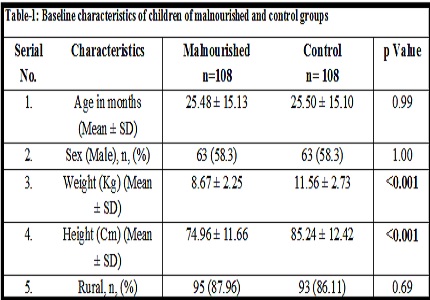Study of lipid profile levels in malnourished and healthy children: a case control study acquired pneumonia in children
Abstract
Background: Under nutrition causes reduced growth and endocrine adaptations in order to maintain basic life processes. Protein energy malnutrition often coexists with micronutrient deficiencies. Malnutrition results from multiple deficiencies, not necessarily limited to lack of proteins or calories, but also involving other associated or separate factors such as deficiency of trace elements, such as copper and zinc and lipid profile.
Methods: A case control study was carried out in department of Pediatrics, Maharani Laxmi Bai (MLB) Medical College, Jhansi from September 2009 to August 2010. 108 cases & 108 matched controls were recruited according to sex, weight and height after written informed consent with the approval of ethical committee. Total cholesterol and fractions (low-density lipoprotein cholesterol, high density lipoprotein cholesterol) and triglycerides concentrations were determined by automated enzymatic methods. The results were analyzed by the appropriate statistical test.
Results: In present study, more than half children were suffered from marasmus as an acute malnutrition and most of children were of below 24 months of age. Total cholesterol, triglyceride and HDL levels were lower in PEM children while LDL & VLDL levels were higher in malnourished children group.
Conclusion: The prevalence of under nutrition and dyslipidaemia observed in these children is a matter of concern considering the age group evaluated. These Biochemical parameters were found to be sensitive indicators for nutritional status and can be used for diagnosis of sub clinical case of protein energy malnutrition (PEM).
Downloads
References
2. Mancharia CW, KOG-MAKAU W, Murok NM. Dietary intake, feeding and care practices at children in kathonzweni, Division, Makuenl, district, Kenya. East Africa Medical journal’ 2004; 81: 5-6.
3. National Family Health Survey-3 (2005-2006) International institute for population sciences, India.
4. Ferraz IS, Daneluzzi JC, Vannucchi H, Jordão AA Jr, Ricco RG, Del Ciampo LA, Martinelli CE Jr, Engelberg AA, Bonilha LR, Custódio VI. [Prevalence of iron deficiency and its association with vitamin A deficiency in preschool children]. J Pediatr (Rio J). 2005 Mar-Apr;81(2):169-74.
5. Ballabriga A. The problem of malnutrition, an introduction. Ann Nestle “ Malnutrition”, 1985; 43 (1) : 1 – 4.
6. Snapper, I. Chinese Lessons to Western Medicine, 2nd ed.; Grune and Stratton: New York, NY, USA, 1965; pp. 55-64.
7. Roseboom, T.J.; van der Meulen, J.H.; Osmond, C.; Baker, D.J.; Ravelli, A.C.; Bleker, O.P. Plama lipid profiles in adults after prenatal exposure to the Dutch famine. Am. J. Clin. Nutr. 2000, 72, 1101-1106.
8. Lussana F, Painter RC, Ocke MC, Buller HR, Bossuyt PM, Roseboom TJ. Prenatal exposure to the Dutch famine is associated with a preference for fatty foods and a more atherogenic lipid profile. Am J Clin Nutr. 2008 Dec; 88 (6):1648-52. doi: 10.3945/ajcn.2008.26140.
9. Lumey, L.H.; Stein, A.D.; Kahn, H.S.; Romijn, J.A. Lipid profiles in middle-aged men and women after famine exposure during gestation: the Dutch Hunger Winter Families Study. Am. J. Clin. Nutr. 2009, 89, 1737-1743.
10. SRIRAMACHARI S, RAMALINGASWAMI V. Liver changes in kwashiorkor. Indian J Pediatr. 1953 Jan;20(77):1-6.
11. Ramalingaswami, V.; Sriramachari, S.; Patwardhan, V.N. Liver injury in protein malnutrition. Indian J. Med. 1954, 8, 441-443.
12. Waterlow, J.C.; De Pass, E. Further observations on the liver, pancreas, and kidney in malnourished infants and children. II. The gross composition of the liver. J. Trop. Pediatr. 1957, 2, 189-198.
13. Goodman DS. The NationalCholesterolEducationProgram: guidelines, status, and issues. Am J Med. 1991 Feb 21;90(2A):32S-35S.
14. Waterlow JC. Kwashiorkor revisited: the pathogenesis of oedema in kwashiorkor and its significance. Trans R Soc Trop Med Hyg. 1984;78(4):436-41.
15. Elizabeth KE, Nutrition and Child Development, 2006, 4th edition, Paras Medical Publisher, Hyderabad.
16. Rao P S S, Richard J: An Introduction to Biostatistics, A manual for students in health sciences, New Delhi: Prentice hall of India. 86-160.
17. Yadav YS, Yadav S, Rathi S, Dhaneria M, Poonam Singh. Comparison of Infant feeding practices among rural and urban mothers: an observational study. Int J Med Res Rev 2015;3(6):547-553. doi: 10.17511/ijmrr.2015.i6.104.
18. Alves JF, Britto RP, Ferreira HS, Sawaya AL, Florêncio TM. Evolution of the biochemical profile of children treated or undergoing treatment for moderate or severe stunting: consequences of metabolic programming. J Pediatr (Rio J). 2014;90:356---62.
19. Joilane Alves Pereira, Patricia Helen Carvalho Rondo, Jesuana Oliveira Lemos, Ellaine de Oliveira, Cinthya Rocha, and Thiago Hipo´ lito. Nutritional Status and Lipid Profile of Young Children in Brazil. Journal of Tropical Pediatrics, 2013; 59(1): 54-58.
20. Gabriela R. S. Veiga, Haroldo S. Ferreira, Ana L. Sawaya, Jairo CaladoandTelma M. M. T. Florêncio. Dyslipidaemia and Undernutrition in Children from Impoverished Areas of Maceió, State of Alagoas, Brazil. Int. J. Environ. Res. Public Health 2010, 7, 4139-4151; doi:10.3390/ijerph7124139.
21. Hendricks KM, Duggan C, Gallagher L, Carlin AC, Richardson DS, Collier SB, Simpson W, Lo C. Malnutrition in hospitalized pediatric patients. Current prevalence. Arch PediatrAdolesc Med. 1995 Oct;149(10):1118-22.
22. Barker DJ. Mothers, babies and health in later life. 2nd ed. Edinburgh: Churchill Livingstone;1998.p.81-93.

Copyright (c) 2018 Author (s). Published by Siddharth Health Research and Social Welfare Society

This work is licensed under a Creative Commons Attribution 4.0 International License.


 OAI - Open Archives Initiative
OAI - Open Archives Initiative


